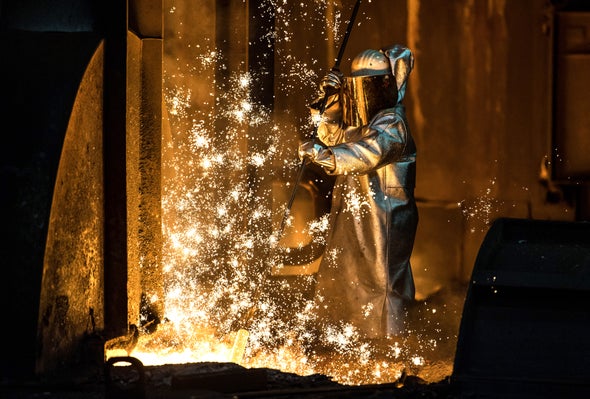The white-hot river of liquid iron never stops. Every hour of the day and night, at this steel plant in Sweden’s far north, the metal pours out of a hole at the bottom of a massive, 90-metre-tall blast furnace. Equally relentless, a stream of carbon dioxide belches out of the top.
The CO2 is a waste product of the coal that the blast furnace devours. For every tonne of iron that will go to make steel, this furnace produces 1.6 tonnes of CO2, says Martin Pei, chief technology officer at SSAB, the company that owns the plant here in Luleå. The world has hundreds of similar blast furnaces, most of them with larger emissions. Add other energy-intensive steps in the industry, and it becomes clear how steel-making causes 7% of the world’s greenhouse-gas emissions, comparable to the exhaust from all the world’s passenger vehicles combined, by some estimates.
But a few hundred metres away from the Luleå furnace is a smaller one that makes iron with much less carbon pollution. This pilot technology replaces coal with hydrogen, and releases only water vapour. “This is the new way to make steel, and with this, we can in principle eliminate all the carbon dioxide,” Pei says.
The hydrogen-to-steel route isn’t entirely pollution-free; other steps in converting iron to steel still emit some CO2, and the iron ore must be mined. Still, last year, this site produced the world’s first ‘green steel’, with the aid of hydrogen that was made using Sweden’s abundant low-carbon electricity, generated from hydropower, nuclear and wind. The pilot plant is owned by HYBRIT, a joint venture that SSAB formed in 2016 with Swedish utility company Vattenfall and LKAB, the national mining company.
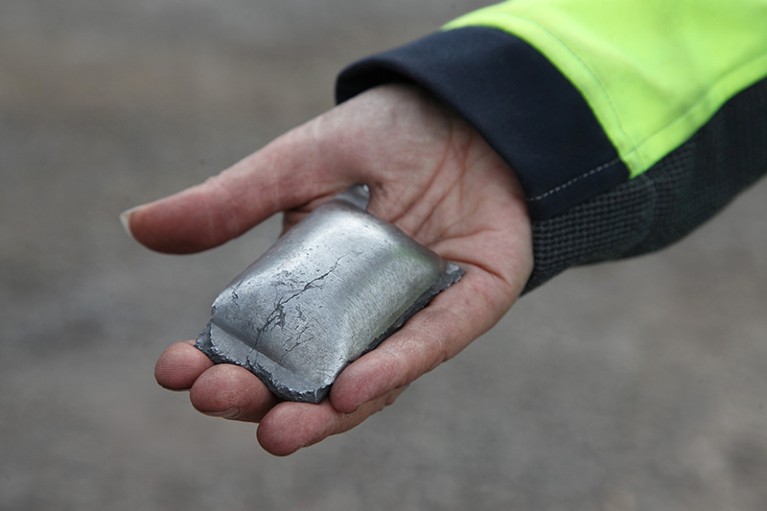
Making steel green is just one of the ways that hydrogen is now expected to help decarbonize the world’s economy. Although some have touted hydrogen’s use as a transportation fuel, it’s unlikely to have much impact in that sector or in heating, for which batteries and electrical power already provide more efficient low-carbon solutions. Rather, hydrogen’s biggest contribution will be to clean up industrial processes, from producing plastics and fertilizers to refining hydrocarbons. These industries have conventionally been thought of as harder to decarbonize, and have received less attention from the media, investors and policymakers.
Hydrogen might find uses in energy production, too. Liquid fuels made from hydrogen might one day power air travel and shipping. And hydrogen could even help to decarbonize the electricity grid: excess solar or wind power could be diverted into making the gas, which could then be used in other industrial processes or simply to store energy. In this way, hydrogen is expected to act as a bridge between many different sectors of the economy.
“Hydrogen is sort of unique because of its versatility in the ways you can produce it and in the ways in which you can use it,” says Dharik Mallapragada, a chemical engineer at the Massachusetts Institute of Technology in Cambridge.
Policymakers anxious to reach net-zero emissions goals have begun a massive push for hydrogen, notably in the United States and the European Union. In some cases, they are subsidizing the price of low-carbon hydrogen; in others, handing out tax credits for hydrogen producers or for industries that use it.
Partly as a result, investment in hydrogen projects is experiencing a boom. The Hydrogen Council, an industry group in Brussels, estimates that the hundreds of large-scale hydrogen projects announced already amount to a possible investment of US$240 billion by 2030 — although so far, only one-tenth of these are fully completed deals. By 2050, the council thinks the market for hydrogen and hydrogen technologies will be worth $2.5 trillion per year.
Analysts now project that the world will see a five- to sevenfold increase in hydrogen production by mid-century (see ‘Hydrogen sources’). This should help to cut the world’s carbon footprint — but only if that hydrogen is itself obtained without adding to CO2 emissions, as it is in the Luleå pilot.
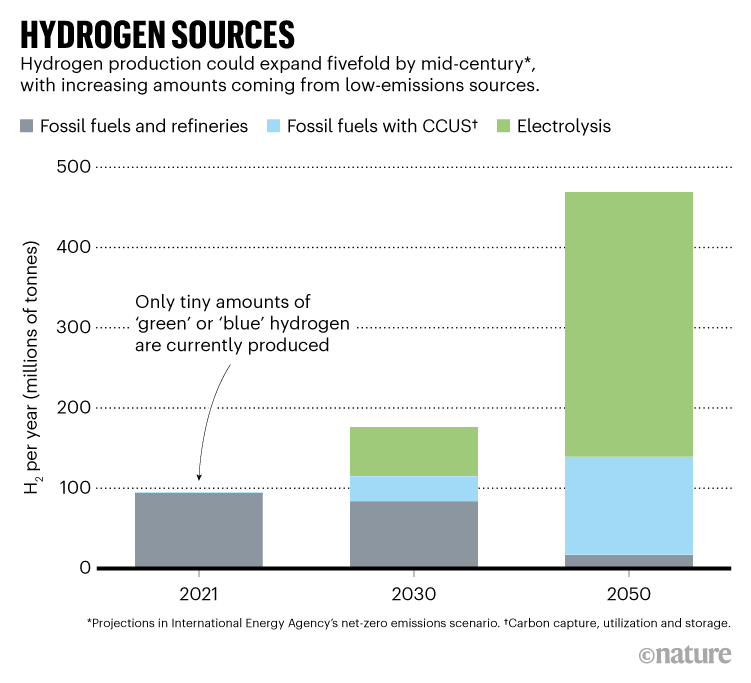
Hype has surrounded hydrogen before. But the amount of money involved this time suggests to many experts that it really will take off. The transition needs no new technology, analysts say: it is already tried and tested, although scientific advances would help speed it up.
“The hydrogen revolution is happening — this time for real,” says Oleksiy Tatarenko, an economist at the Rocky Mountain Institute (RMI), a sustainability think tank in Boulder, Colorado.
Where to begin?
Hydrogen production is already a sizeable — and polluting — industry. The International Energy Agency (IEA) estimates that around 94 million tonnes (Mt) of the gas is made each year. Almost all of it comes from fossil fuels such as natural gas. Methane (CH4) in natural gas reacts with oxygen to turn into hydrogen molecules and CO2. The latter is then vented into the atmosphere — 900 million tonnes of it each year, or more than 2% of world CO2 emissions, comparable to the total annual emissions of Indonesia and the United Kingdom combined. Analysts refer to this polluting hydrogen as ‘grey’.
The hydrogen the world already makes is largely used for chemical processing steps in essential industries. It is mixed with nitrogen from the air to make ammonia (NH3), for instance, an ingredient in fertilizer. Petrochemical refineries use hydrogen to remove sulfur from petroleum, or to break down some of petroleum’s larger hydrocarbons into smaller ones. And in the chemical industry, hydrogen goes into making massive amounts of products, such as methanol (CH3OH), which in turn is used in the synthesis of countless other chemical commodities.
“Before we position hydrogen as the solution for climate change, we first have to deal with hydrogen as a problem in climate change,” said Michael Liebreich, an energy consultant and chief executive of Liebreich Associates in London, in a keynote speech at the World Hydrogen Congress in Rotterdam, the Netherlands, in October.
Some of the CO2 released by making hydrogen from fossil fuels could be captured and stored underground, in deep geological reservoirs. Hydrogen decarbonized in this way is dubbed ‘blue’. But critics of blue hydrogen point out that it doesn’t prevent all CO2 emissions, and that making blue hydrogen means continuing to extract natural gas, which comes with its own environmental downsides.
Another way to make hydrogen can be almost completely carbon-free. This is the 200-year-old technique of water electrolysis: electrolysers extract the H from H2O by running an electric current between catalyst-plated electrodes. If the energy used to power this process is renewable, the resulting product is called green hydrogen. Green hydrogen has the potential to be zero-emission, or at least close to it.
A crucial factor in determining the speed of the switch to clean hydrogen will be the cost of electrolysers. The IEA, clean-energy analysts BloombergNEF and other organizations predict that this could fall rapidly — dropping by more than two-thirds by 2030 — as electrolysers are made in increasingly automated assembly lines, rather than built by hand.
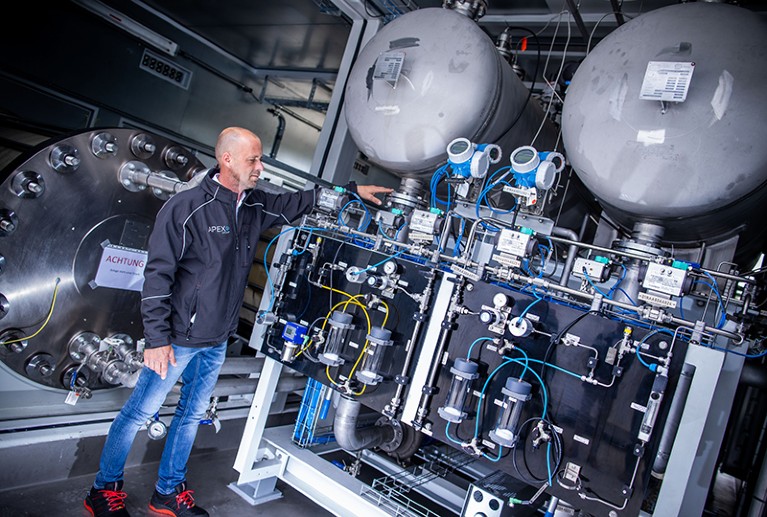
This is why analysts predict that the cost of making green hydrogen will drop from around $5 per kilogram now, to $1 per kg in the future, even without subsidies such as tax breaks. That would make it competitive with grey hydrogen, which can be made for less than $1 per kg (when wars don’t raise the price of natural gas, as has occurred in Europe). Even so, multiple studies predict that as demand booms, a large proportion of hydrogen demand will need to be fulfilled by blue hydrogen for decades to come.
The transformation will require huge amounts of renewable energy. If electrolysers were 100% efficient, it would take more than 3,000 terawatt hours (TWh) of electricity from renewable sources each year just to replace the grey hydrogen used today with green hydrogen; in reality, the electricity required is more likely to be above 4,500 TWh. That is comparable to what the United States generates in a year. What’s more, the IEA envisions a future in which clean hydrogen’s annual electricity requirements rise to 14,800 TWh, in its scenario of a net-zero-emissions world by mid-century.
Still, clean energy is growing at a remarkable pace. By 2024, for instance, BloombergNEF projects that the world is expected to have the capacity to produce almost 1 TW of photovoltaic panels each year: that alone could meet one-seventh of today’s annual electricity demand. Overall, the world’s low-emissions electricity supply is already set to more than triple by mid-century, says the IEA — although even more aggressive expansion is needed for a net-zero world in 2050 (see go.nature.com/3nxtvhj).
Steeling up
Of all of industry’s carbon spewers, steel is one of the largest — and it is the sector where hydrogen could have the biggest impact. People had tried to use hydrogen in the process for years, Pei says, but couldn’t get it to scale up. But in 2016, right around the time when most countries signed the Paris climate agreement pledging to keep global warming to less than 2 °C above pre-industrial levels, Pei began to spearhead hydrogen research at SSAB. It was clear that decarbonizing steel was crucial for Sweden to meet its Paris commitments. SSAB is not a major steel producer, yet it alone accounts for 10% of Sweden’s CO2. “Everyone knew that if SSAB wouldn’t succeed in taking away those emissions, Sweden would not succeed,” company spokesperson Mia Widell says.
The hardest problem with making steel is that it involves extracting iron from iron ore — which is essentially rust, containing iron in an oxidized form. In a blast furnace, oxygen atoms are stripped from this rust, leaving liquid iron behind. To do this, ore is melted together with coke (a derivative of coal) or with charcoal. The main function of this fuel is not actually to melt the ore, but to grab oxygen atoms from it, in a chemical reduction process that has a thermodynamic cost more than six times greater than that of melting the rock. This process leads to the release of vast amounts of CO2.
SSAB considered ideas such as capturing emitted CO2 and storing it underground, but concluded that would be too expensive. Instead, it chose the hydrogen pathway. Hydrogen can diffuse inside pellets of solid iron ore and remove oxygen, in a process called direct reduction of iron (DRI), which takes place at 600 °C instead of the more than 1,500 °C of a blast furnace (see ‘Greener steel’).
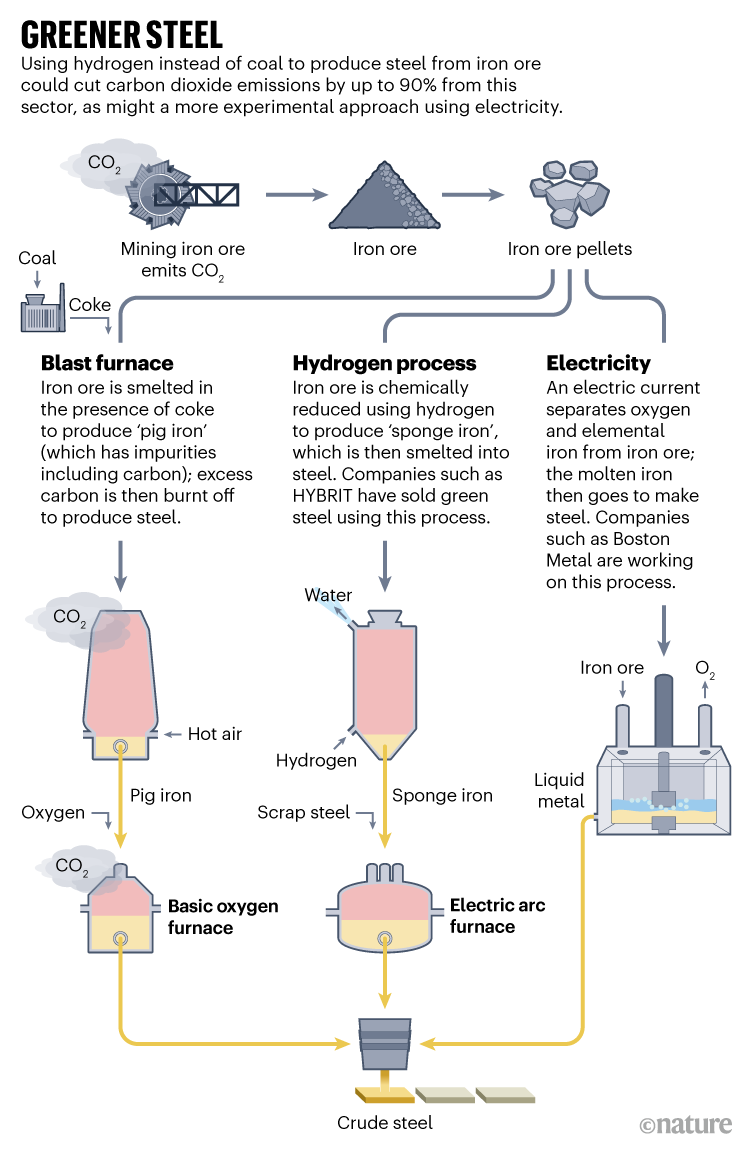
DRI existed long before HYBRIT started using hydrogen for this process: some of today’s steel is made this way using natural gas, but that leads to carbon emissions that using clean hydrogen would avoid.
HYBRIT’s Luleå trials were so successful that SSAB decided to move forward the date to shut down its blast furnaces, from 2045 to 2030, says Pei. HYBRIT is building its first full-size plant in Gällivare, a town 200 kilometres north of Luleå, and has made the results of its research publicly available, hoping to create momentum for the whole industry, he says. Half an hour’s drive from Luleå, a Stockholm-based start-up company called H2GreenSteel has broken ground for an even larger plant, and says it has sold 1.5 million tonnes of its product in advance.
Because smelters last for decades, energy analysts say that if nations are to meet the goals of the Paris accord, the steel industry should immediately stop building new blast furnaces and instead begin replacing them with hydrogen-ready direct-reducers. Even if most initially use natural gas, they will be able to gradually wind down their carbon footprint while hydrogen supply ramps up over the next three decades.
“There’s no space in the carbon budget for new blast furnaces,” says Rebecca Dell, head of the industry programme at the ClimateWorks foundation, a grant-making organization in San Francisco, California.
Many steel-makers are taking the DRI route, although in China and India, new blast furnaces are being planned, according to the non-governmental organization Global Energy Monitor, also in San Francisco. The task is so immense, however, that some organizations, including BloombergNEF, forecast that some blast furnaces will still be active at mid-century, and that carbon capture will have to be deployed to help reduce their emissions.
In principle, steel production might even become completely electrified, avoiding the need to make hydrogen, which could improve efficiency further, says Dell. Electrolysis can split iron oxide, and several start-up firms, such as Boston Metal in Woburn, Massachusetts, are trying to put this to use in steel-making. For now, however, hydrogen is the front runner. “The major advantage of the hydrogen approach is that [it] has the smallest increment of new technology required to get truly clean steel-making,” says Dell.
A hydrogen bridge
In the long run, it’s possible that hydrogen’s biggest contribution to slowing global warming might be as a bridge across disparate activities — electricity, construction, manufacturing and transport — making it cheaper to fully decarbonize all of them together than it would be if each sector tried to decarbonize separately, says Christian Breyer, an energy-systems analyst at Lappeenranta–Lahti University of Technology in Finland.
The crucial node in this interconnected web will be electricity generation. Here, hydrogen could help to solve a well-known drawback of renewable energy: although plentiful, it is spread unevenly across the hours and seasons, and is often unpredictable. This makes it tricky for regions to plan for long periods without it.
Researchers who work on simulations that try to balance supply and demand in future electric grids have to plan, for instance, how to supply electricity if winds aren’t blowing for a week in a cold, dark winter in Europe. Scientists have a name for this phenomenon: Dunkelflaute, a German word that roughly translates as ‘dark doldrums’.
Batteries will help to balance supply and demand from one hour to the next, but once the share of wind and solar grows past 80% of a grid’s electricity mix, it becomes extremely expensive to make grids resilient to Dunkelflauten, according to some studies (see, for example, J. D. Jenkins et al. Joule 2, 2498–2510; 2018). One solution being considered is to build enough extra wind turbines to get a grid through even the stillest winters, and then to use them for most of the year to make hydrogen. This hydrogen could then be sold to industrial customers — to steel mills, or for liquid fuels for transportation, shipping and export.
In particularly dire times of the year, it could be used to generate electricity again by burning it in turbines similar to those that run on natural gas, although this would be very wasteful: the grid would get back only one-third or less of the electricity originally put into making the hydrogen.
It’s not clear whether this is the most cost-effective way to decarbonize the last 20% of electricity, compared with building nuclear-power stations or perhaps expanding geothermal energy. The optimal mix will probably vary between countries, suggest region-specific studies by organizations such as the United Nations International Renewable Energy Agency.
Myths and misconceptions
Although hydrogen has myriad possible applications, that doesn’t make it the best solution to all problems. For passenger cars, batteries have already largely won the race, because they are a more efficient and less costly solution than carrying around a tank of hydrogen and converting its energy back to electricity.
Another area where it probably doesn’t make sense to use hydrogen is as a fuel for heating homes. If the hydrogen is grey — made from natural gas — then it simply adds to global warming, says Rebecca Lunn, a civil engineer at the University of Strathclyde in Glasgow, UK. She and others flagged home heating as a problematic use for hydrogen in a UK National Engineering Policy Centre (NEPC) study, released in September (see go.nature.com/3ut5mj5).
But even if the hydrogen is green — made from renewables-generated electricity — it is up to six times more efficient to use that electricity to heat homes directly using, for instance, heat pumps, which reach efficiencies much higher than 100% by sucking heat in from the outside.
To cut emissions fastest, policies should prioritize improving home insulation, which will cut down the need for heating energy whatever its source, says Nilay Shah, a researcher in process-systems engineering at Imperial College London, who led the NEPC study.
Hydrogen forecasts
Investment in low-carbon hydrogen had been soaring for the past several years, but events this year have triggered what seems to be a veritable boom.
In the United States, the Inflation Reduction Act has introduced a tax break of $3 for every kg of green hydrogen, in addition to a number of other policies and pots of funding for the gas. In Europe, Russia’s aggression against Ukraine has brought a new sense of urgency. In March, the European Commission set a target of producing 10 million tonnes of H2, and importing an additional 10 million tonnes, per year by 2030. Many other major economies have set national strategies to develop hydrogen capacity.
“Everything has changed — the whole equation,” says RMI economist Patrick Molloy. The US tax breaks, in particular, have brought the cost of green hydrogen there down to grey hydrogen’s roughly $1 per kg, or lower, depending on location (see ‘Costs of clean hydrogen’). This already makes hydrogen-based steel, ammonia and liquid fuels competitive with their fossil-fuel counterparts, the RMI calculates.
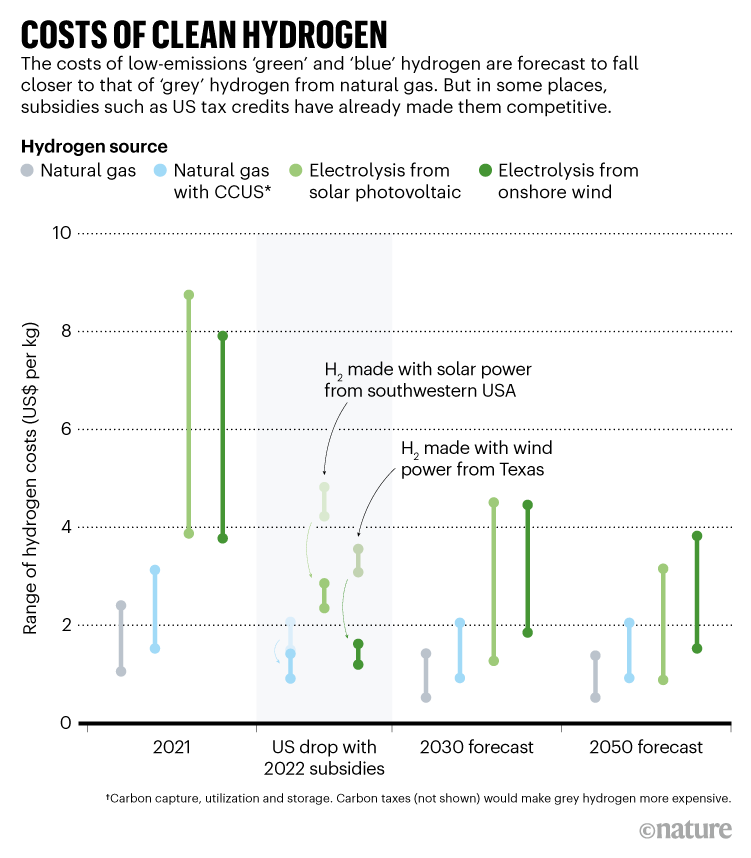
Without subsidies, clean-hydrogen products — such as green steel — could still be more expensive than their dirty equivalents. HYBRIT and H2GreenSteel do not disclose how much they expect their products will cost to make. Governments might also adopt policies to buy green steel, as the administration of US President Joe Biden has pledged to do under a Buy Clean provision in an executive order passed last December.
The IEA projects that by 2030, global hydrogen demand might rise by 20–30%. The low-carbon hydrogen projects that are in the pipeline so far will be enough to cover only about one-quarter of that. That suggests that hydrogen expansion plans are not yet ambitious enough: for the world to be on track for net-zero emissions by mid-century, some 180 Mt of hydrogen production is needed by 2030, with half of it low-emissions.
But Tatarenko says it is not out of the question that global green-hydrogen production could reach what’s necessary in 2030. “We should be super ambitious.”
Others warn that the push for hydrogen might end up boosting the non-green kind as well, and therefore perversely increasing CO2 emissions. In particular, a controversial measure under consideration by the European Commission would water down the EU definition of green hydrogen, allowing it to be produced in part with electricity generated from fossil fuels.
Reorganizing the economy to accommodate hydrogen will bring social repercussions. Even with subsidies and massive investment, heavy industry in some regions will still be at a competitive disadvantage. Because hydrogen is more expensive and technically challenging to transport than coal, industries such as steel-making might end up having to move closer to sites where hydrogen can be produced cheaply, says Dell. “They may even be in different countries.”
Although this and other political issues could slow down the pace of the transition, there are no longer any unsolvable challenges, she adds. “Making this transition is entirely within both our technical and economic capacities, both in high-income countries and in emerging economies,” says Dell.
This article is reproduced with permission and was first published on November 16 2022.

